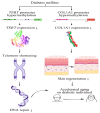Exploring the impact of diabetes on aging: insights from TERT and COL1A1 methylation
- PMID: 39296334
- PMCID: PMC11407328
- DOI: 10.55730/1300-0152.2701
Exploring the impact of diabetes on aging: insights from TERT and COL1A1 methylation
Abstract
Background/aim: Aging, a multifaceted biological process, leads to diminished physical performance, especially in older adults with diabetes, where a mismatch between biological and chronological age is noticeable. Numerous studies have demonstrated that diabetes accelerates aging at the cellular and organ levels. Notable aging markers are telomerase reverse transcriptase (TERT), related to telomere length, and type 1 chain collagen (COL1A1), a key component of skin collagen. Additionally, age-related methylation increases, as revealed through methylation analysis, augmenting aspects of aging. However, the detailed interplay between aging and diabetes, particularly regarding methylation, remains underexplored and warrants further study to elucidate the biological links between the two.
Materials and methods: In this study, we elucidate the modulatory influence of diabetes on the aging process, focusing specifically on the modifications in TERT in the kidney and COL1A1 in the skin using mice of Swiss Webster strain as the diabetes model. Specimens were categorized into three distinct chronological cohorts: chronologically young (16 weeks; n = 5), chronologically old (40 weeks; n = 5), and a periodically assessed group (16 weeks; n = 30), from which five mice were systematically sacrificed on a weekly basis.
Results: Our findings reveal a marked impact of diabetes on the methylation statuses of TERT and COL1A1, characterized by an elevation in methylation levels within the periodic group (1st-6th week) and a simultaneous, progressive attenuation in the expression of TERT and COL1A1 genes.
Conclusion: The observed alterations in the methylation levels of TERT and COL1A1 propound the hypothesis that diabetes potentially expedites the aging process, concomitantly impinging on the production of TERT and COL1A, ostensibly through the mechanism of promoter gene hypermethylation.
Keywords: Aging; diabetes; marker; methylation; promoter.
© TÜBİTAK.
Conflict of interest statement
Conflicts of interest: The authors declare that they have no conflicts of interest.
Figures






References
LinkOut - more resources
Full Text Sources
Miscellaneous
